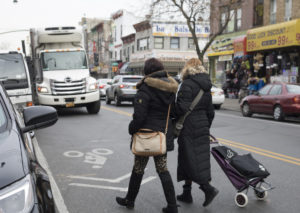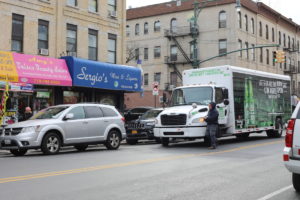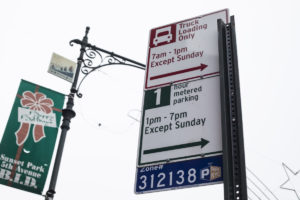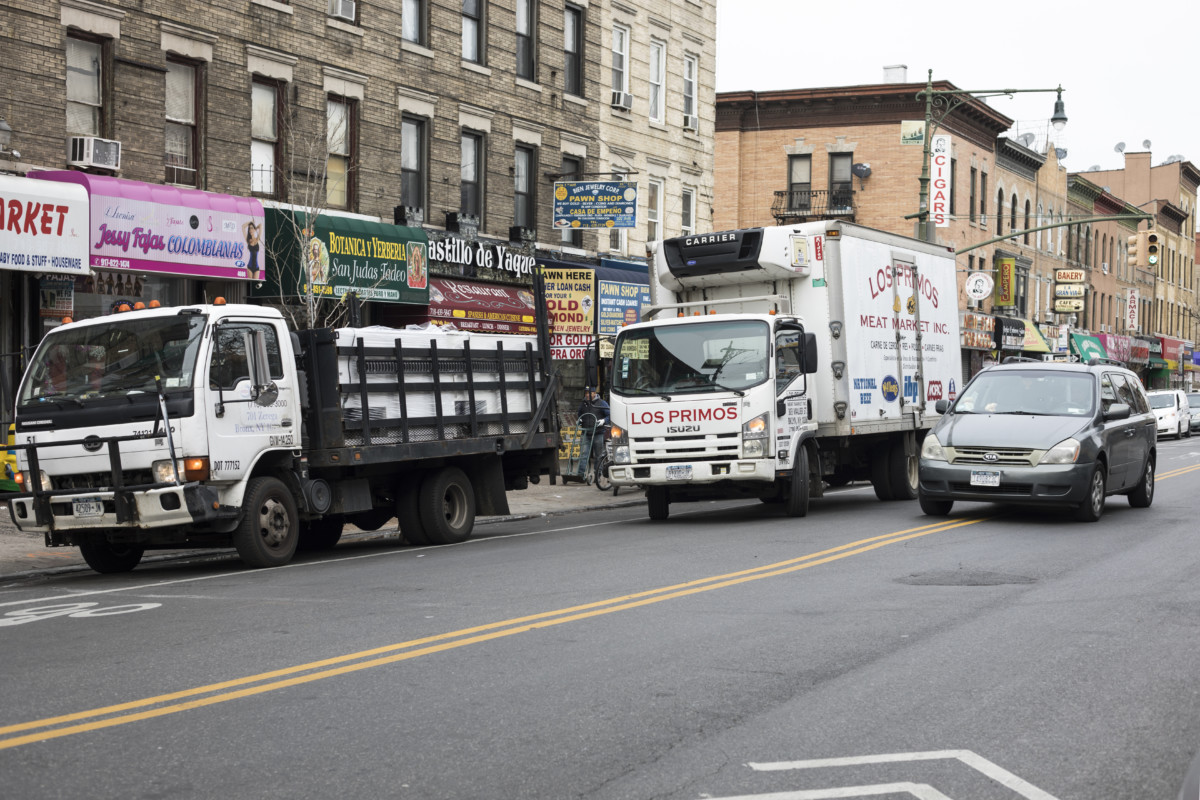Along Fifth Avenue in Sunset Park, hundreds of small businesses are lined up, from 39th street to 62nd street — grocery stores, Laundromats, liquors stores, and more. But the people who use this busy and lively street sometimes face danger. The street is too narrow for its traffic, and what’s worse, delivery trucks partially block the way, diverting cars, bikes, and pedestrians out into oncoming traffic.
Community Board 7 presented this problem to the public during its last monthly meeting and proposed possible solutions. But solving the problem can be a complicated puzzle, as one person’s solution is another person’s headache.
The problem
According to Officer Wing Chan, the 72nd Precinct’s Neighborhood Coordination Officer, the traffic on the Fifth Avenue comes in many different forms — pedestrians, cyclists, livery cabs, yellow cabs, delivery trucks, and more. The road has two lanes each way — one for parking and one for traffic. Bicycles don’t have a separate lane; instead, they share the traffic line with motor vehicles. So it can get chaotic.

What is worse, during business hours, dozens of delivery trucks come to Fifth Avenue and can’t find a proper space to park. To stay on their delivery schedule, many of them have no choice but to double park in the traffic line. As a result, drivers behind them have to swing to the opposite lane to go around these parked trucks, and so do cyclists. These trucks also block oncoming traffic’s vision and put pedestrians in danger. During the most recent community board meeting, Zachary Jasie, Community Board 7 transportation committee chairman, said that many students get off buses on Fifth Ave and walk to their schools. When they cross the street, he said, these blind zones are safety threats to them.
The puzzle
Ticketing the trucks
Giving tickets to illegally parked trucks has been one tactic used in the past in the hope of eliminating these violations. This has been proved ineffective.

Gavbano Ramos, a grocery store attendant who helps with unloading deliveries regularly, believes this tactic not only doesn’t solve the problem but also gives him and his truck driver friends obstacles to completing their jobs. Police officers often ask them to park on the other side of the street, he said, or even to another block. Unable to park right in front of the store means they have to carry groceries through heavy traffic and the crowd on the street. Ramos says dollies full of groceries are hard to maneuver, and he worries that pedestrians could get injured during such journeys, or that he could.
Meanwhile, many drivers don’t mind getting tickets. According to Jasie, many delivery companies have funds set aside to pay for parking volitions, so drivers themselves don’t have enough motivation to avoid a ticket.
Truck-only hours
The first solution Community Board 7 presented, at November 15 meeting, was to have commercial-only parking during the morning hours. But this solution has its pros and cons.

Ramos is strongly in favor of this proposal. Such a regulation would be helpful during morning rush hours, and drivers wouldn’t need to risk their lives unloading in the middle of the street, he says. “No one wants to park on the bike line,” he says. And, he adds, truck-only hours is working elsewhere. “A nearby street is already doing that, and we should do that as well.”
But: While this solution might benefit drivers and business operators, it could also force residents who park on Fifth Avenue to find alternative parking spots. And for those who park overnight on Fifth, it means they would have to wake up in the early morning to move their vehicles to nearby streets. However, parking space is already extremely limited in the area. George Santiago drives to 5th Avenue every day to visit his mom or take her to the hospital. Every time he comes, he says, he spends up to two hours trying to find a parking space. If street parking gets more limited, he foresees even more trouble.
Night deliveries
A second proposed solution at the meeting was this: asking business owners to arrange night time deliveries with their drivers, voluntarily. Yet this solution has its upsides and downsides, too. The idea behind it, of course, is if trucks come during non-rush night hours, they will have far less impact on the traffic. Santiago supports night deliveries, and says, “That’s what I’m thinking.” This solution would not add pressure to the parking situation, and less dense traffic during the day could reduce traffic jams.
However, such an arrangement is hard to enforce, and may not even improve the situation. If night deliveries become mandatory, stores may have to adjust their staffing schedules to accommodate the change.
Some stores are willing to make such changes. Sergio Katz, the owner of Sergio’s Wine & Liquors, supports the proposal because, as he points out, he and his customers need to park during the day. “Trucks should come when no one is using the street,” he says. However, Ramos doesn’t agree, “No one wants to come to work at night. Trucks won’t agree to come at night as well.”
Next steps
The double-parking problem at Fifth Avenue seems simple, but the solutions must take many stakeholders into considerations. Jasie encourages the community to get creative. Community Board 7 is collaborating with the NYC Department of Transportation to study the problem and encourages the public to submit ideas.


Leave a Reply